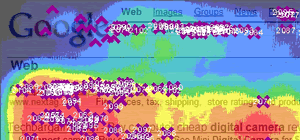I ran across an interesting article on WebProNews.
Editors Note: The Search Engine Strategies conference kicked off in New York yesterday. As usual, there are a number of panels featuring some very useful and educational information.One such panel attended by Andy Beal detailed the many different types of search behavior. This section detailed how searchers respond to search results. Are they satisfied or do they have to conduct another search?With this in mind, how does the behavior of visitors coming from search engines affect the design and optimization of your site? Discuss in WebProWorld.I love looking at the various surveys and studies that float around in the search space. So you can imagine the drool running down my chin, at the thought of the "Search Behavior" session. Panelists shared details of various recent surveys. It was a cornucopia of search trivia.
Dr Bonny Brown Director of Research and Public Services,
Keynote Systems, gave details of their study of 2000+ panelists who were invited to log on to the web using a browser companion that measures browsing habits and asks questions.
They revealed which of the search engines were the most popular. No surprises that Google was the top rated search engine. What was interesting is that out of all of the votes cast, Yahoo, MSN and Ask Jeeves all had double digit gains (compared to the same study 6 months ago), while Google maintained the lead, its growth was the lowest among the big four. A sign the Google juggernaut might be losing a little steam.
Other useful snippets from Brown:
1 in 2 searchers will use another search engine, if they cannot find what they are looking for.
1 in 3 searchers use search engine toolbars - the greatest retention tool the search engines ever created, in my opinion.
17% of searchers use different search engines for different types of searches.
Gord Hotchkiss of
Enquiro will probably never have to worry about losing his "search behavior monitoring" crown. As kids today say, "he rocked".
His new study - to be released later today, so you're getting a sneak peak - demonstrated that despite all of the things we think lead to click-thrus and sales,
"rank" and
"page position" are still the two most important factors to searchers.
Who gets the share of clicks? The number one organic position received 27.4% of all organic clicks, while 51% of all who click on paid results, pick the top paid search listing. This clearly shows that in paid search, you need your ad to be in the top position, while in organic, you can be in the top 3 to 5 results and still get a good share of the click-thrus.
Hotchkiss then went on to display a graph that demonstrated how confidence in search results reduces, the longer it takes a searcher to find what they are looking for. Changing their search request, gave the searcher a brief bump in confidence.

It may be hard to top the next piece of data shared by Hotchkiss. He demonstrated his eye-tracking survey (50 participants) - where participant's eye movements were tracked to accurately record which search results received the most attention.
He showed a Google search results page with an "eye tracking map" that looked similar to a thermal imagery chart (with the "hotspots" showing the most eye contact). The study distinctly showed most eyes look at the top left corner of the search results, with a small coverage at the top of the paid search results.
Hotchkiss explained that a users' eye is drawn to a triangle pattern which he named "Search's Golden Triangle", with searchers scanning from the top left to the page's "fold" line and then left (in a triangle pattern). While the triangle did not really extend below the fold, 60% of participants scrolled down below the fold, with only 40% taking a look at the paid search results on the right (above fold).
Finally he shared some data on how page position impacted visibility and ultimately click-thrus.
For Organic Results on Google:100% visibility for the top 3 organic results
85% for the No.4 position
60% for the No. 5 position
For Organic Click-Thrus on Google:28% click on the No.1 position
Drops to 12% by position No. 3
Remainder share 3-12% of click-thrus
For Paid Search Results on Google:90% visibility for the top 2 AdWords advertisers
50% visibility for the No.3 position.
About the Author:Andy Beal is Vice President of Search Marketing for WebSourced, Inc
